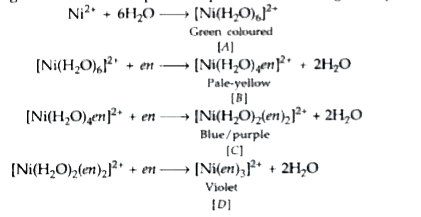A chloride of fourth group cation in qualitative analysis gives a green coloured complex [A] in aqueous solution which when treated with ethane-1, 2-diamine (en) gives pale-yellow solution [B] which on subsequent addition of ethane-1, 2-diamine turns to blue/purple [C] and finally to violet [D]. Write the structures of complexes [A], [B], [C] and [D].
The formation of complexes is explained as under :

Topper's Solved these Questions
- COORDINATION COMPOUNDSBOOK - U-LIKE SERIESCHAPTER - COORDINATION COMPOUNDSEXERCISE - LONG ANSWER QUESTIONS-I (3 marks each)
85 Videos
- COORDINATION COMPOUNDSBOOK - U-LIKE SERIESCHAPTER - COORDINATION COMPOUNDSEXERCISE - SELF ASSESSMENT TEST
7 Videos
- COORDINATION COMPOUNDSBOOK - U-LIKE SERIESCHAPTER - COORDINATION COMPOUNDSEXERCISE - VERY SHORT ANSWER QUESTIONS (1 mark each)
69 Videos
- CHEMISTRY IN EVERYDAY LIFEBOOK - U-LIKE SERIESCHAPTER - CHEMISTRY IN EVERYDAY LIFEEXERCISE - LONG ANSWER QUESTIONS - I
21 Videos
- ELECTROCHEMISTRY BOOK - U-LIKE SERIESCHAPTER - ELECTROCHEMISTRY EXERCISE - SELF ASSESSMENT TEST (SECTION D)
1 Videos
Similar Questions
An organic compound (A) with molecular formula C6H6O gives a characteristic colour with aqueous FeCl3 solution. When (A) is treated with CO2 and NaoH at 410 K under pressure, it gives compound (B) which upon acidification gives compound (C). compound (C) reacts with acetyl chloride to give (D) which is a popular pain killer. deduce the structure of (A), (B), (C) and (D) and explain all the reaction involved.
View SolutionAn organic compound 'A' having molecular formula C6H6O gives a characeristic colour with aqueous FeCl3 solution. When 'A' is treated with CO2 and NaOH at 400K under pressure, compound 'B' is obtained. The compound 'B' upon acidification gives compound 'C' which reacts with acetyl chloride to form 'D'. It is a polular pain killer. Deduce the structures of A, B, C and D.
View Solution
Knowledge Check
Which of the following colour change occurs when tridentate ligand, ethane-1, 2-diamine (en) is progressively added to an aqueous solution of nickel (II) chloride ?
AGreen to pale blueBGreen to purple blueCGreen to violetDAll of theseIn qualitative analysis when H2S is passed through an aqueous solution of salt acidified with dil. HCl, a black precipitate is obtained. On boiling the precipitate with dil. HNO3, it forms a solution of blue colour. Addition of excess of aqueous solution of ammonia to this solution gives
Adeep blue precipitate of Cu(OH)2Bdeep blue solution of [Cu(NH3)4]2+Cdeep blue solution of Cu(NO3)2Ddeep blue solution of Cu(OH)2.Cu(NO3)2In qualitative analysis, when H2S is passed through an aqueous solution of salt acidified with dil.HCl, a black precipitate is obtained. On boiling the precipitate with dil. HNO3, it forms a solution of blue colour. Addition of excess of aqueous solution of ammonia to this solution gives
Adeep blue precipitate of Cu(OH)2Bdeep blue solution of [Cu(NH3)4]2+Cdeep blue solution of Cu(NO3)2Ddeep blue solution of Cu(OH)2.Cu(NO3)2
A white substance (A) reacts with dilute H2SO4 to produce a colourless suffocating gas (B) and a colourless solution (C )/ The reaction of gas (B) with potassium iodate and starch solution produce a blue colour solution. Aqueous Solution of (A) gives a white precipitate with BaCl2 solution which is soluble in dilute HCl. Addition of aqueous NH3 or NaOH to (C ) produced first a precipitate which dissolves in excess of the respective reagent to poduced a clear solution. Similarly addition of excess of potassium ferrocyanide to (C ) produced a precipitate (D) which also dissolves in aqeous NaOH giving a clear solution. Identify (A),(B),(C ) and (D ). Write the equation of the reactions involved.
View SolutionA white substance (A) reacts with dilute H2SO4 to produce a colourless suffocating gas (B) and a colourless solution (C )/ The reaction of gas (B) with potassium iodate and starch solution produce a blue colour solution. Aqueous Solution of (A) gives a white precipitate with BaCl2 solution which is soluble in dilute HCl. Addition of aqueous NH3 or NaOH to (C ) produced first a precipitate which dissolves in excess of the respective reagent to poduced a clear solution. Similarly addition of excess of potassium ferrocyanide to (C ) produced a precipitate (D) which also dissolves in aqeous NaOH giving a clear solution. Identify (A),(B),(C ) and (D ). Write the equation of the reactions involved.
View SolutionIn qualitative analysis when H2S is passed through an aqueous solution of salt acidified with dil. HCl, a black precipitate is obtained. On boiling the precipitate with dil. HNO3, it forms a solution of blue colour. Addition of excess of aqueous solution of ammonia to this solution gives
View SolutionIn qualitative analysis when H2S is passed through an aqueous solution of salt acidified with dil. HCl, a black precipitate is obtained. On boiling the precipitate with dil. HNO3, it forms a solution of blue colour. Addition of excess of aqueous solution of ammonia to this solution gives
View SolutionWhich one gives a red precipitate with ammoniacal solution of copper(I) chloride?
(A) Ethane
(B) Ethene
(C) Ethyne
(D) Propane
View Solution
